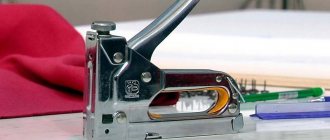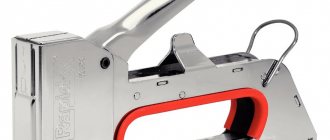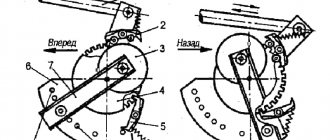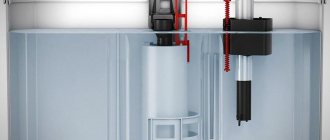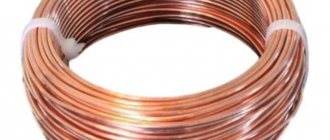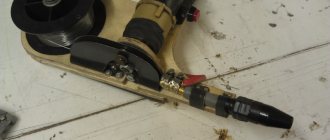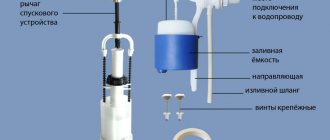Icer
5047 0 1
Icer April 27, 2018Specialization: master in the construction of plasterboard structures, finishing work and laying floor coverings. Installation of door and window units, finishing of facades, installation of electrical, plumbing and heating - I can give detailed advice on all types of work.
Today we will figure out how to make your closet more convenient to use using a device such as a pantograph. This is a special system that allows you to raise and lower the bar under the hangers at the moment you need. Thanks to this design, compartments with clothes can be located in the upper part of the closet, freeing up space below for shelves.
Pantograph is a very convenient element in modern clothing storage systems
What is a pantograph and how does it work?
What is pantorgaf? This is a device designed for storing clothes in the under-ceiling space of a wardrobe at an inaccessible height. Helps save space and makes it easier to take out and hang clothes.
The pantograph is most often used for storing things in wardrobes
All pantographs are a U-shaped or L-shaped structure, which consists of several parts:
- Barbell. All models offer a sliding rod, the size of which can be adjusted to fit the width of the cabinet. Clothes are hung on it.
- Side levers. These are the load-bearing elements that hold, raise and lower the barbell. They come with two or one side fastenings.
- Lifting mechanism. Provides movement of levers. This is a system of springs, hydraulics or gas shock absorbers, which is housed in plastic casings. Electrically driven devices are also available.
- Lever. Attached to mechanical models for pantograph control.
The principle of operation is simple: by pulling or pushing the handle, you can lower and raise the bar with hanging clothes to the required height. Electric drives are controlled by a button or remote control.
Additional accessories for the pantograph in the wardrobe
The most popular are the so-called pantograph expanders. They are necessary if the width of the niche for installation is greater than the free opening. Pantograph extensions for clothes allow you to “narrow” the active width of the hanger so that it freely passes into the designated opening without encountering obstacles in its path.
Also, as an additional accessory to the pantograph, you can purchase a telescopic handle separately. It will allow you to remove the hangers from the bar without lowering the pantograph itself.
For additional comfort, we recommend screwing coat hooks to the inner side of the cabinet. It is very convenient to choose clothes and hang hangers on the lowered pantograph, when it is possible to temporarily place them somewhere, freeing up your hands. For the same purpose, you can purchase a retractable hanger holder.
Retractable rods of various designs can also be used as a “temporary shelter” for removed hangers from the pantograph of a wardrobe. They can be attached both to the back of the shelves and to the sides of the niche.
Advantages and disadvantages
In most cases, a pantograph helps improve the quality of life. But it also has disadvantages.
Advantages:
- makes it easier to find, get and hang things in the closet;
- improves ventilation: clothes are fresher;
- makes it easier for older people and people with disabilities to get things;
- frees up the lower part of the cabinet for additional shelves;
- reduces the need for ironing: you can hang more clothes than in a regular closet.
Judging by the reviews, breakdowns occur on average after 3-4 years.
The main disadvantage is wear and tear over time. Gradually, backlashes form between the structural parts, which disables the entire mechanism.
It is almost impossible to repair individual parts of the pantograph; the entire system has to be replaced.
This design is inferior to a conventional horizontal hanger bar, which can last forever
Another drawback is the possible creaking of parts during operation. This becomes a problem if the closet is located in a shared bedroom. Compared to a regular bar, pantographs are significantly more expensive and require more complex installation.
Rules for placement and operation
If the sliding wardrobe is selected in a furniture store or made to order, most likely the installation of the pantograph will be done by a craftsman. However, if you want to improve the functionality of an old home cabinet, you can install this mechanism yourself.
First, you will have to study the location of the shelves inside the wardrobe. If there are no niches for placing clothes on hangers, remove several shelves. If there is a niche, stock up on the latest tools:
- measuring tape, simple pencil;
- screwdriver;
- magnetic holder, bits for hardware;
- drill 3 mm;
- hex wrench.
Once the list of tools has been prepared, begin installing the mechanism. To determine the current location of the crossbar, consider what clothes will hang on it. If dresses, coats, the crossbar are mounted at a level of 1-1.2 m from the bottom shelf. If only jackets and blouses are at the level of 0.8 m.
It is extremely important to determine the lower level of the product, for which you will need to measure its height (from the bottom of the box with the lifting mechanism) and add another 30 mm to this value.
In order for the installation to be more reliable, of high quality, and for the structure to withstand maximum weight, it is important to drill the racks for self-tapping screws. When fixing mounting strips and levers to the side wall of the cabinet and installing a rod with a handle, it is important to accurately match the holes in the strips with the previously prepared blind holes in the partitions. It is important not to confuse the right-hand and left-hand levers, and also not to overdo it with pressure when screwing in the screws. Otherwise, the work will have to be repeated from the beginning.
As for the operating rules, they are simple. It is important not to overload the structure, specifying the maximum permissible weight of clothing in the instructions.
How to choose
Most stores offer mechanical models, prices for which start at 2,000 rubles. Depends on the material, load capacity, type of lifting mechanism and manufacturer.
Prices for electric elevators are tens of times higher, even for models with similar characteristics.
What to look for when choosing:
- Material. Steel parts are durable, aluminum parts last less. The plastic must be highly durable.
- Load capacity.
Focus on the average weight of clothing. If it exceeds the load-carrying capacity of the device, then failure in a short time is inevitable. It is better to purchase models with a load capacity of 12, 15, 18 kg, with the exception of small sections of the cabinet. - Type of lifting mechanism. It is better to choose pantographs with gas and hydraulic lifting mechanisms. These lifts have a soft ride and will last longer than spring mechanisms.
- Manufacturer. Models from Chinese manufacturers are cheaper, but they creak more often, do not work stably, and are poorly fixed at the lower level. According to testing results, the highest quality ones are from the following manufacturers: SERVETTO, VIBO, AMBOS.
- Control type. In this matter, they focus on the budget. Of course, electrical devices are more convenient than mechanical ones.
- Bar sizes. The dimensions of the rod are indicated on each model. When choosing, they are guided by the width of the cabinet section where the pantograph will be mounted. The bar should be positioned freely between the walls and not touch the doors while moving. The removal of the rod outside the cabinet is also taken into account. This is important when space is limited.
You can learn about the actual service life and problems of a particular model from consumer reviews. Pay attention to the warranty period from the manufacturer. The larger it is, the better the quality of the device.
Article about furniture
Author - designer of the company DEZALT Sukhanov Eduard
When is a pantograph needed?
In short, and without wasting your time, the pantograph should be installed as a last resort, when you have a lot of outerwear and you need to hang it in the second row above the bar. Only in this case install a pantograph.
Now in more detail.
The minimum distance for short clothing from the floor to the bar is 90 cm, this is the minimum. This size fits a men's shirt, trousers folded in half, a jacket, but nothing more. If your jacket is knee length, it won't fit anymore.
The normal size for short outerwear is 120cm, but if you like something just below the knees, it’s better to make the distance under the barbell 140cm, you can’t go wrong.
If you like long raincoats, fur coats, dresses, then you need to leave a distance of at least 150cm, and preferably 170cm. We once had a client who was about 180cm tall and she was a ballroom dancer. We made the distance to the bar more than 2 meters so that the dresses would not lie on the floor.
You can go and measure your clothes hanging on hangers, from the bar to the bottom. Give a margin of 10cm. and you can safely put the resulting height in the new cabinet.
And now we are approaching the pantograph. There are cases when there is not enough space, but there are a lot of clothes on hangers, you need to put them somewhere. The first rod is set at 150cm. from the floor, about 120-130cm remains on top. (of course this depends on the height of the room). In this case, you can install a pantograph on top of the bar. It is more suitable for storing things up to 120cm. in length, because if you hang long clothes, when lowering and lifting them, they swing strongly and sometimes even the hem of the clothes lies on the floor in the lowered state.
Example
To lower the pantograph, you need to grab the central handle and pull it towards you. You will feel resistance, especially when the pantograph is empty and still brand new. When he is under the weight of clothes, it will be easier to lower himself.
Different manufacturers indicate approximately the same load on the pantograph, from 10 kg. up to 14. The width of the pantograph can be different, there are several standards for different sections: From 500 to 750mm, from 530 to 680mm, from 690 to 990mm, from 860 to 1150mm, from 750 to 1250mm. As you understand, you can choose a pantograph for a section from 500 to 1250mm.
The price of pantographs also varies greatly, depending on the manufacturer, from 2000 rubles. up to 14,000 rub. The most expensive ones I've met are Italian. Perhaps there are other manufacturers that I have not even heard of, perhaps with higher prices, but I will rely on my experience.
The most common version of the pantograph is symmetrical, when it looks like the letter P. It is usually attached to the sides of the cabinet on the left and right, with a hanging handle in the center. A lesser-known design is the asymmetrical pantograph, it resembles a beech G and also has a handle for lowering. Our company has never installed such a pantograph; I can’t say anything about this design.
The pantograph lifts clothes using a gas or oil mechanism. Here I do not undertake to say which one is better and which one will last longer. From practice, I know that Chinese pantographs, which cost around 2-4 thousand, fail after 3-5 years of operation. Alas, this happens. There are of course exceptions when it works for 7-10 years. Italian ones are still of better quality in this regard; they last for 7 years or more. We have not yet learned the limits of their work, since no one has yet complained about Italian mechanisms. Perhaps people simply do not contact us and solve the problem on their own. And to be honest, we installed them infrequently, over the entire period (since 2009) maybe 5 times, because the price is very high compared to Chinese ones, 3 thousand versus 8.
Turkish pantographs are somewhere between China and Italy in quality, but there are also surprises. Once we were installing a Turkish pantograph and when the mechanism was lowered, the plastic rubbed against the tube with a characteristic sound. We studied everything carefully, the reason was in the body of the right mechanism, the clearance for the tube stroke was less than that of the left. The geometry of the cabinet body or the installation method were done correctly, we double-checked everything, it was just a manufacturing defect. In order not to waste time replacing the pantograph, so as not to get on our nerves with the supplier, to prove that we are not to blame, we carefully disassembled the right mechanism and ground off the plastic at the attachment points by a few millimeters. This solved the problem.
When the pantograph is empty, when lifting it up, you need to hold the handle with your hand, otherwise it will crash into the wall by inertia. When the clothes are hanging, firstly, the pantograph will not rise so sharply, and secondly, the handle should slow down on the hanging clothes.
Most often, pantographs are mounted on the sides of the cabinet, directly on the chipboard. Be very careful and attentive with the length of the screws included, sometimes they are longer than required. For example, we use 16mm thick laminated chipboard. and sometimes the self-tapping screws that come with the kit can be several millimeters longer, apparently designed for panels 18mm thick. You can go right through with self-tapping screws.
There are pantographs with wall mounting, we installed this once. I think they are designed more for dressing rooms, because sometimes laminated chipboard stands are unnecessary in dressing rooms and it turns out that there is nothing to attach the pantograph to. Perhaps that’s why they came up with wall-mounted ones. Wall pantographs are rare and their selection is small. We bought an Italian one from Ambos for 12,000 rubles. approximately, I repeat, they simply did not find an alternative.
How do expensive pantographs differ from cheap, less famous ones? As I said, firstly, by service life, and secondly by quality, which is understandable only in comparison. Another plastic, it does not have an unpleasant odor. All edges of all parts are without sharp burrs, there are no unnecessary roughnesses. The connecting elements are similar to Chinese samples, but it feels like they are made well.
The only thing that was surprising to me was that the U-shaped structure of the elevator did not have any additional strength when lowering and raising it. In the same way, the tubes play left and right and sway slightly. I still expected that the mechanism would lower evenly, even more smoothly, without the slightest distortion. Nothing like this. The work is no different from its Chinese counterparts. The brakes are a little softer in the lower and upper positions, but there are no more differences.
Is it possible to do without a pantograph? Yes, it is possible and many get by. If you are willing to stand on a small stool or stepladder to remove or hang clothes from the ceiling, then you do not need a pantograph. Upstairs you can hang clothes that are currently unnecessary. There is also a telescopic hanger stick that can be used to hook the hanger and hang clothes on the bar.
All pantograph designs are narrowed, this is done so that when lowering the tubes they do not touch swing or compartment doors. It turns out that you lose about 10cm. useful length of the rod. In general, all retractable furniture fittings, such as mesh baskets, trouser holders, tie holders, shoe racks, are all a waste of space inside the closet. Such things can be justified in the dressing room when there is free access to them, you do not have an urgent need to save every centimeter. But in the closet, the extension mechanisms eat up the volume. There are restrictions on the depth and length of retractable fittings. You can lose space not only from the sliding mechanisms, but also from the shallower depth. For example, your closet is 60cm inside, but your basket is only 50cm. That means 10cm. goes nowhere. If you make a drawer or shelf from chipboard, there will be more benefits.
I told you all the features about pantographs, my personal conclusion is this - if you really need a second row of clothes for every day, install a pantograph, preferably a branded one.
Well, if you can do without it, it’s better to refuse. All articles
Types of pantographs
Pantographs can be mechanical or electrical.
All models are divided by material of manufacture:
- steel;
- aluminum.
By rod width:
- 450 - 600 mm;
- 600 - 800 mm;
- 800 - 1150 mm;
- other parameters;
Pantographs are also designed for different load capacities. The kit comes with instructions and mounting hardware.
Mechanical
Mechanical pantograph
These are easy-to-install and operate devices. Lifting mechanisms are gas, hydraulic and spring.
| Mechanical models | ||||
| Manufacturer, model | SERVETTO ONLY | AMBOS 700 | VIBO Ambrogio | LEMAX |
| Lifting mechanism | hydraulic | hydraulic | hydraulic | hydraulic |
| Section width | 600-1200 mm | 750-1150 mm | 500-750 mm | 600-830 mm |
| Rod type | telescopic | telescopic | telescopic | sliding |
| Load capacity | 12 kg | 15 kg | 14 kg | 12 kg |
| Material | steel, plastic | chrome steel, plastic | steel, plastic | metal, plastic |
| Color | grey, brown | white | grey | silver |
| average price | 9100 rub. | 6200 rub. | 7050 rub. | 3250 rub. |
Electrical
Electric pantograph SERVETTO
Controlled by a button connected by a wire to the system unit or remote control. Much more convenient to use, but require complex installation by a qualified electrician. Electrically driven pantographs are generally made to order.
Characteristics of the SERVETTO ELECTRICAL model (made to order).
| Manufacturer country | Italy, SERVETTO |
| Lifting mechanism | electric drive, connection to 220 v network |
| Control | remote controller |
| Section width | 830-1150 mm |
| Rod type | telescopic |
| Material | nickel, plastic |
| Color | black |
| Load capacity | 15 kg |
| Average price with delivery | 59,000 rub. |
To order an electric pantograph, you need to contact manufacturers' representatives. This can be done through the official websites.
Pantographs are indispensable for all tall cabinets and dressing rooms - they help to properly distribute space and maintain order. As for the main drawback - wear and tear - this can be prevented. To do this, purchase models from trusted manufacturers and adequately evaluate price and quality. Durable materials, good workmanship and reliable mechanisms cannot be very cheap.
Features and principle of operation
The design of the pantograph is not complicated. The service life depends on the quality of the materials used and the processing of parts. When choosing, you should give preference to trusted manufacturers; saving in this case is not practical. Cheap models often break down after just a couple of months; repairs take a lot of time and effort. In most cases, it is cheaper to buy a new mechanism than to repair an old one.
With its help you can easily remove clothes from the upper sections of furniture.
The device consists of the following elements:
- levers – load-bearing elements for manipulating the barbell;
- lifting mechanism - a complex system that sets the entire structure in motion;
- rod - a telescopic handle with the ability to change length, designed for hanging clothes;
- handle - designed to control the pantograph.
Pantographs for sliding wardrobes are divided into electric and manual (mechanical).
The brackets are fixed to the walls of the wardrobe, the height depends on the length of the handle of the structure. The distance from the ceiling of the wardrobe to the end of the handle should be 3-5 mm. The handle is easy to put on; the plastic castings snap onto the “ears” of the bracket. The telescopic pipe is fixed to the bracket handle with screws.
Weight category 10-15 kg – not suitable for heavy winter jackets, down jackets and fur coats, will not support their weight.
Pantographs with mechanical and electric levers are available for sale. A wardrobe lift works on the same principle, but its installation requires more time and effort. A mechanical pantograph can be installed on your own; installation of a model with an electric drive requires professional knowledge.
The furniture pantograph can withstand loads of up to 20 kg. The manufacturer always indicates the maximum weight. The length of the device is 45-125 cm. The longer the structure, the more weight it can withstand.
Simply pull the special handle (item 5 on the list), and the entire barbell with hangers will go down.
The most vulnerable part of the structure is the springs, due to which the levers are lowered and raised. Malfunctions most often occur from overloads or strong jerks. Good manufacturers use quality springs designed to last for many years. Compliance with operating rules plays an important role.
Concept
The pantograph is most often used for storing things in wardrobes. This device is also called a “furniture elevator.” And yet, what is a pantograph? From the definition it follows that a pantograph is a structure whose purpose is to improve the function of a wardrobe. It is made of steel or aluminum in a U-shape.
Pantographs are available in several sizes. The size of a furniture lift depends on the width of the cabinet or other furniture where the potential buyer wants to install it. Moreover, the size of the pantograph working rod is not the only thing you should pay attention to when purchasing such a useful device. But more on that later.
Varieties and materials
By design, sliding wardrobes are divided into two types - cabinet and built-in. The first option is almost no different from ordinary furniture - it also has a bottom, top cover and walls. If necessary, cabinets can be easily moved to a new location. It is possible to transport such furniture without disassembling it, although this reduces its strength. Other advantages include making the most of the space occupied, although they require more space than a built-in wardrobe. Due to the need for additional materials, such a model will cost more.
The height of a built-in cabinet is from floor to ceiling, the width is usually from one wall to another. This increases the efficiency of using the occupied space. The absence of walls and top allows you to save the amount of materials and time for assembly. The disadvantages of this option include the impossibility of moving it to another part of the room. If the built-in wardrobe is moved, cosmetic repairs to the ceiling and floor will have to be made at the former installation site.
The standard form of compartment products is linear or elongated along the wall, which is suitable for large rooms. In rooms where there is not enough space to install full-size furniture, you can place corner cabinets. A radius model with closed elements made of curved glass would look good in the hallway - but this type of three-door coupe will be the most expensive.
Hull
Built-in
Linear
Radial
Chipboard is most often used for the box and filling of the structure.
However, when choosing, the main attention should be paid to the facade of a three-door wardrobe; for its manufacture they use:
- Chipboards - MDF or chipboard. On top they can be covered with films of different colors that imitate natural wood and other textures. They are durable and affordable.
- Mirrors. This facade visually makes the room more spacious. A coupe with a sandblasted pattern allows you to further decorate the interior.
- Glass. Different options are used - matte, colored or transparent. The most impressive look is glass with photo printing.
- Composite materials. Gives the closet a more modern look.
- Natural wood. It is rarely used due to its high cost and heavy weight, but it looks respectable and expensive. A more profitable alternative to a wooden facade is MDF sheets covered with veneer.
MDF
Chipboard
Mirrors
Glass
Composite materials
Natural wood
Fusing
Universal mechanism
Where else can you find a pantograph? In order not to clutter the reader's head with complex descriptions that are usually found in encyclopedias and dictionaries, it is better to remember the mechanism that is on the roof of the tram. It also has a diamond shape and is the driving force of transport.
In this case, the transformation of the pantograph occurs due to the reception of current. The lifting mechanism is similar in design to an articulated multi-link and is involved in the movement of the contact runner in a vertical position.
Of course, the tram example is not the only one. A pantograph is a universal device found in electric trains and electric locomotives. In terms of its functions, this mechanism has nothing in common with the one used in drawing. But due to similar forms it received just such a name.
What are the distinctive features of a pantograph?
A pantograph (also called a walking eurobook) is easy to use. It has a built-in pendulum device, which is the basis of the transformation. Thanks to springs and rods, the movement is synchronized, and the absence of additional elements allows the structure to be strong and reliable, while reducing cost.
To unfold you need to pull the loop that is sewn to the seat. This will lift it up. Then you need to move the seat forward and lower the backrest down. At the same time, the sofa lowers additional legs for support and stands on them. The structure is ready. It turns out to be a double bed, without joints. Very often, such structures are equipped with handles that allow you to fold the structure back without effort.
Note! A distinctive feature of the pantograph mechanism is the absence of rollers that could scratch the floor during disassembly of such a model.
The cost of such sofas depends on the manufacturer and durability. There are 2 types of transformation:
- Manual. Cheap option. But when unfolding, you will have to make an effort by manually lowering the pillows from the back onto the resulting surface of the sofa.
- Automatic. This design is much more expensive. But it is easier to use, because the pillows will fall on their own, without your help.
Important! The average price of pantograph models is 25,000 rubles.
General conclusions
- Pay close attention to the mechanism when buying a sofa. The ease of use and service life of the sofa will depend on choosing the right mechanism.
- Match your needs with its capabilities. How often will you unfold the sofa, what space do you have allocated for installing the sofa, especially when unfolded.
- Don’t choose a sofa with a mechanism that is obviously not suitable just because the color is cool or because your neighbors have one. Choose individually for your needs.
What does peppermint look like and how does it differ from other types?
Purpose of the device
Usually, people who want to purchase or make a furniture elevator themselves are less interested in the exact definition of this concept. And indeed, the answer to the question “pantograph - what is it” does not give an accurate idea of whether it is needed at all?
In fact, this mechanism is practical and interesting. If you list all its useful functions, you will get something like this:
- storing things in empty compartments of the wardrobe;
- systematization of clothing according to the “winter-summer” principle;
- assistance with daily activities for people with disabilities, children or short adults;
- space saving;
- maintaining a neat and tidy appearance of clothing.
As you can see, a pantograph for a closet is quite a useful thing. And it will undoubtedly find its application in every home.
